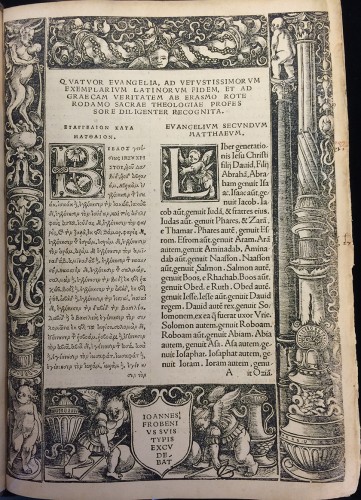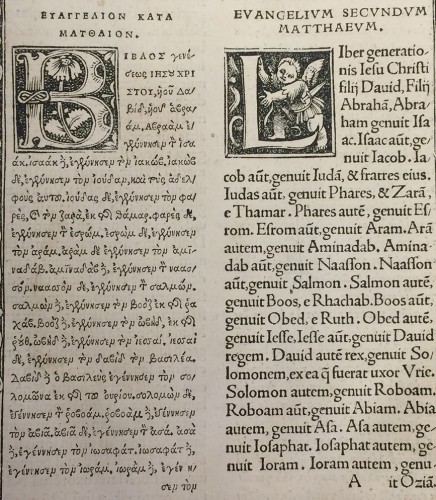Around 1511, the Dutch Catholic humanist, Erasmus of Rotterdam (1466-1536), began working on an edition and Latin translation of the Greek New Testament, for which he thoroughly compared the text of several Greek manuscripts with Jerome's fourth-century Latin translation of the Bible, the so-called Vulgate. As a true scholar always striving to publish an accurate and elegant edition, Erasmus introduced numerous stylistic improvements and even important corrections in Jerome's version, which was indeed a very audacious deed, considering that for centuries the Catholic Church had based its theological teachings on a close reading of the Vulgate. In 1516, exactly five hundred years ago, Erasmus's edition, along with his translation, was published in a single volume by Johann Froben in Basel. A fully annotated copy of this landmark edition is held at the Special Collections Library.
The odd title, Novum Instrumentum, attests to Erasmus's very diligent efforts to get the translation right. He argued that, strictly speaking, a testamentum is an intention or will communicated orally, whereas the instrumentum is its written materialization. Thus, the stories about Christ and his apostles were expressed in the oral tradition as a testamentum, turning into an instrumentum when these stories were actually written down for posterity.
Froben might have been anxious to be the first to publish the Greek New Testament. He knew that in Alcala de Henares, Spain, an ambitious project to publish a multi-language edition of the Bible in six volumes (Biblia Complutense) was underway. In fact, the part of the New testament had been printed in 1514 but was not published as volume five until 1522. The postponement was the result of Froben and Erasmus obtaining an imperial privilege as described on the title page: cum privilegio Maximiliani Caesaris Augusti. In a few words, this privilege forbade the printing of the Greek Testament in the Holy Roman Empire, or even importing it from outside the Empire, for the next four years.

The letter by Pope Leo X endorsing the translation was printed as a Preface. Erasmus often mentioned this letter in correspondence with his friends to justify his changes to the Vulgate version. A former owner playfully drew three weasels, which represent the coat of arms of the Wesel family. Novum Instrumentum omne, diligenter ab Erasmo Roterodamo recognitum & emendatum. Basel: Johann Froben, 1516
The volume is divided into two parts. The first contains parallel columns with the new edition of the Greek text on the left, and beside it a Latin translation designed to replace Jerome's version. The second part includes a commentary with alternative translations, some of which became rather controversial from the theological point of view.

Beginning of the Gospels in Novum Instrumentum omne, diligenter ab Erasmo Roterodamo recognitum & emendatum. Basel: Johann Froben, 1516

Detail of the beginning of the Gospels in Novum Instrumentum omne, diligenter ab Erasmo Roterodamo recognitum & emendatum. Basel: Johann Froben, 1516

Our copy has been fully annotated by a sixteenth-century reader, as shown in this page of the second part containing the Commentaries in Novum Instrumentum omne, diligenter ab Erasmo Roterodamo recognitum & emendatum. Basel: Johann Froben, 1516
Erasmus's Novum Instrumentum had an enormous impact on the religious reformation of the subsequent decades of the sixteenth century. In many ways, Erasmus had challenged the ecclesiastical authorities by studying the Bible in the original language as opposed to the old tradition of relying on the Vulgate or on other asssigned intermediaries. The fact that this new edition included the Greek text along with the new Latin translation generated a linguistic, and theological, debate that would continue in future translations of the Bible into Latin and into the vernacular languages. Regarding the study of Bibles published after Erasmus's landmark edition, the Special Collections Library is a unique resource. Indeed, we can safely boast that we hold most of the major translations of the Bible published in the sixteenth and seventeenth centuries.